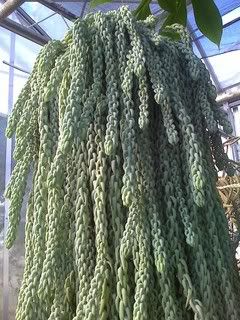Burro's Tail

Sedum morganianum, commonly known as Burro’s Tail or Donkey’s Tail, is an interesting succulent plant that makes for an eye-catching hanging basket. The branches can get to be quite long, provided they don’t get knocked around – this plant is pretty delicate. The fleshy leaves resemble jelly beans with a slightly pointed tip and have a greenish-blue cast to them.
 Like most succulent plants, Burro’s Tail likes to get a lot of sun. Direct sun is best, but partial or filtered sun will do. Lots of sun will stimulate the most growth and may even bring some little flowers. The flowers of Burro’s Tail are small but pretty and are pink.
Like most succulent plants, Burro’s Tail likes to get a lot of sun. Direct sun is best, but partial or filtered sun will do. Lots of sun will stimulate the most growth and may even bring some little flowers. The flowers of Burro’s Tail are small but pretty and are pink.
Burro’s Tail likes a very well-drained potting mix, and be sure that there are holes in the bottom of the pot. Err on the dry side with this plant, as rot is impossible to recover from. It is recommended that water soluble fertilizer be used for this plant. Not much is needed, so use sparingly. I give my Burro’s Tail fertilizer at every other watering.
Propagation of Burro’s Tail couldn’t possibly get any easier: simply take a few of the fleshy leaves and lay them on some potting mix. Lightly water and wait, rehydrating the soil occasionally. It may take a few weeks, but eventually the leaves will begin to send out roots. Each leaf will begin a new plant, so it’s a great idea to sow them in a ready-to-go hanging basket.
The leaves of Burro’s Tail are so suited to growing on their own that they can break off of the main plant really easily. It can actually be pretty frustrating. If you bump the plant, a handful of leaves might fall off leaving large segments of bare branch. Do not despair! These bare places will send out new branches and the plant will fill out again. Of course, lots of sun will help speed that up.
Burro’s Tail likes to rest in the winter months and takes its cue from the shortening days. Leaving the plant in an area that isn’t drafty but is on the cool side is great. Don’t bother to fertilize during this time and cut back on water as well.
This plant is non-toxic, but I want to acknowledge that some people believe this plant to be toxic. Sedum morganianum, the exact plant in the photograph, is not poisonous. It is always possible that certain people may have an allergic reaction to any plant, but in general, this plant is perfectly safe. If you have any doubts, keep it up high or don’t grow it in homes with pets or children. As with all houseplants, they are not meant to be edible.

Burro’s Tail likes a very well-drained potting mix, and be sure that there are holes in the bottom of the pot. Err on the dry side with this plant, as rot is impossible to recover from. It is recommended that water soluble fertilizer be used for this plant. Not much is needed, so use sparingly. I give my Burro’s Tail fertilizer at every other watering.
Propagation of Burro’s Tail couldn’t possibly get any easier: simply take a few of the fleshy leaves and lay them on some potting mix. Lightly water and wait, rehydrating the soil occasionally. It may take a few weeks, but eventually the leaves will begin to send out roots. Each leaf will begin a new plant, so it’s a great idea to sow them in a ready-to-go hanging basket.
The leaves of Burro’s Tail are so suited to growing on their own that they can break off of the main plant really easily. It can actually be pretty frustrating. If you bump the plant, a handful of leaves might fall off leaving large segments of bare branch. Do not despair! These bare places will send out new branches and the plant will fill out again. Of course, lots of sun will help speed that up.
Burro’s Tail likes to rest in the winter months and takes its cue from the shortening days. Leaving the plant in an area that isn’t drafty but is on the cool side is great. Don’t bother to fertilize during this time and cut back on water as well.
This plant is non-toxic, but I want to acknowledge that some people believe this plant to be toxic. Sedum morganianum, the exact plant in the photograph, is not poisonous. It is always possible that certain people may have an allergic reaction to any plant, but in general, this plant is perfectly safe. If you have any doubts, keep it up high or don’t grow it in homes with pets or children. As with all houseplants, they are not meant to be edible.
This site needs an editor - click to learn more!
You Should Also Read:
Non-Toxic Houseplants
Caring for Houseplants in Winter
Houseplants Newsletter 
Related Articles
Editor's Picks Articles
Top Ten Articles
Previous Features
Site Map
Content copyright © 2023 by Lisa Beth Voldeck. All rights reserved.
This content was written by Lisa Beth Voldeck. If you wish to use this content in any manner, you need written permission. Contact
BellaOnline Administration
for details.


